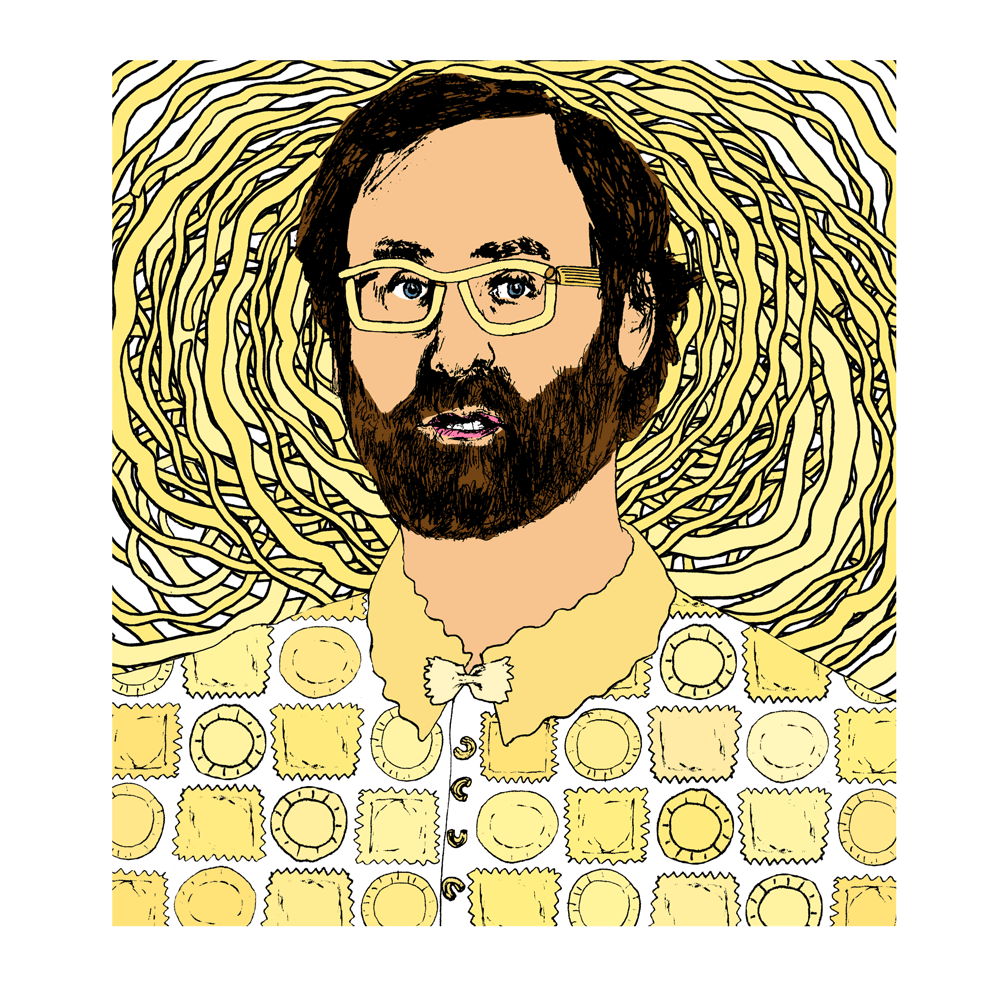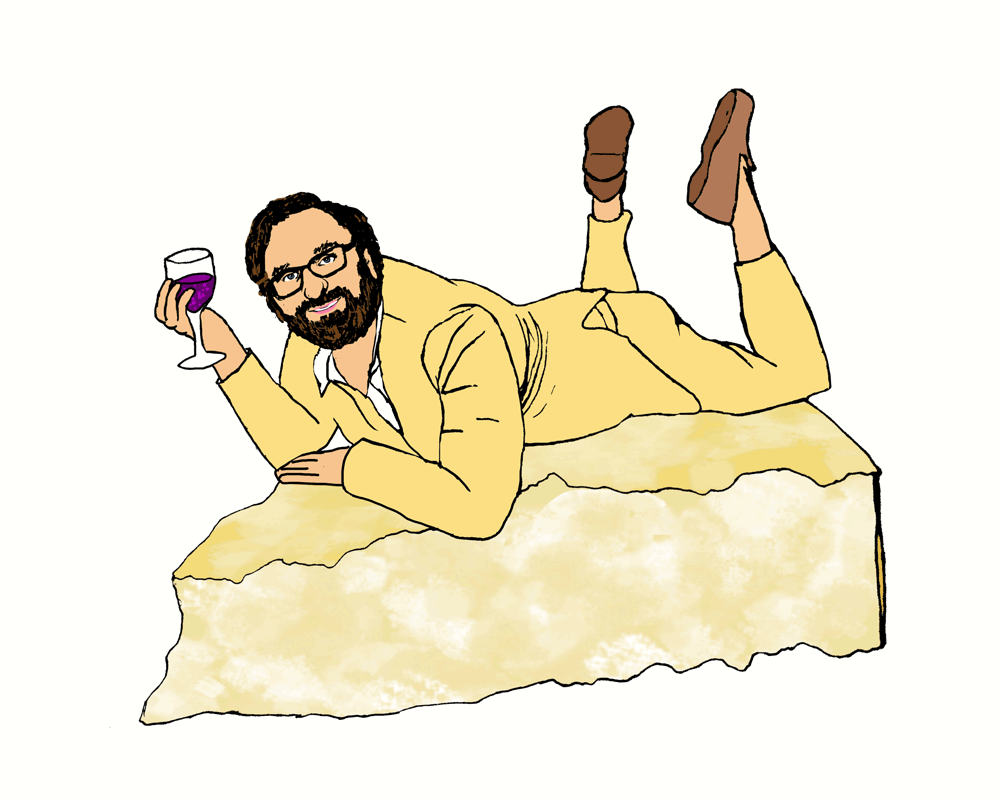
The actor, director, and comic spent weeks filming his Netflix series in northern Italy. The food was pretty good.
My first clue that season two of Master of None was going to take even more of a foodie-ish turn came from a friend who worked in the props department of the Netflix series. “Eric just called a meeting. He says he and Aziz’s characters are only drinking natural wine this season. Do you know anyone who can help?” (Natural-wine importer Selection Massale jumped to the rescue and delivered cases of their wine to set.)
Then there were the tantalizing Instagram posts, hashtagged “#BigBudLilBud,” which turned out to be showing scouting trips for the new season: Eric and Aziz at Pizzarium in Rome, eating ravioli in Parma, drinking orange wine in the Tuscan countryside, getting their Fiat stuck in a tiny back alley in Sicily. Fans of Master of None, take note: That hilarious scene in season two, episode two, was a harrowing reality for our dear Big Bud and Little Bud.
Master of None, which has been nominated for 10 Emmys and won three, was many viewers’ introduction to Eric Wareheim. But he’s a legendary cult comedian and the cocreator, with Tim Heidecker, of the Adult Swim shows Tom Goes to the Mayor and Tim and Eric Awesome Show, Great Job! In addition to directing several episodes of Master of None, Wareheim has directed music videos for Blonde Redhead, Beach House, and even (100 percent unofficially!) Kanye West. He also has his own winemaking project, California-based Las Jaras, which is no joke—even if one of their bottlings is named Sweet Berry Wine after the John C. Reilly sketch from Awesome Show. I caught up with Wareheim to find out what he learned filming (but mostly eating and drinking) in Emilia-Romagna: the proper balance of ragù to tagliatelle, whether it’s possible to get sick of lambrusco, and just how amazing Osteria Francescana really is.
Why did you guys decide to film in Emilia-Romagna? What was special about that place for you?
Well, we were looking for a place that wasn’t blown out by tourists. We wanted to shoot in a place that was beautiful and, well, new. Not a lot of people knew about Modena. We were debating shooting in Sicily and some other places—there’s been so much shot in Tuscany and Rome and Venice, but when we found Modena, it was just perfect.
How much did the region’s food and wine factor into your decision?
I mean, it was massive. When we were shooting, we’d shoot really long days—12 or 13 hours—and then we would drop everything and get on a train to go eat somewhere because we were so obsessed with the food. We had our friend Katie Parla with us; she was translating slash our food concierge, and in the morning she’d run out and get us little sandwiches and bites of salumi and stuff. So food was a massive part of the experience and just worked with the story as well.
Do you have any tips for Americans traveling to Emilia-Romagna and Modena for the first time?
Yeah. The biggest thing I learned was to throw away your American impatience. The first time I went to Italy, I would have plans for “an apéro here, then dinner, then we’ll go to a bar…” and that just doesn’t work in Italy. You go to dinner, and you’re there for three hours, pretty much. My biggest tip for friends is to say, “Get rid of half of your plans. Just be there; just absorb it.”
Also, another thing that food freaks like us do is to want to order everything on the menu. And that also does not translate to Italy. They don’t understand it. Aziz and I would order four pastas.
[Laughs] “This one, he’s very tall, but that one, he’s very small—will he make it?”
Exactly. They’re like, “No, no.” There’s almost no concept of “to go.” You order one pasta, and you eat it.
The scene in Osteria Francescana is such a love letter to restaurants and food. Either you guys are incredible actors, or you were genuinely blown away by what you were eating.
Yeah, it was crazy. Do you know the story behind why we shot there? We actually shot at Giusti, in Modena, which I consider one of the best meals of my life—I would say it was close to a perfect experience. It’s a tiny restaurant, only a couple of seats. Pastas were perfect. So we ate there, we shot there, and Aziz and I were having a drink at a bar one night and Massimo [Bottura] comes in and says, “Why aren’t you shooting at Osteria Francescana?” And we were like, “Dude, you’re the number-one restaurant in the world; we don’t want to bother you!” And he said, “No. I am part of this town. You guys come in for lunch tomorrow, and we’ll kick out the people who have reservations in the private dining room. We’ll shoot with real food, we’ll shoot with real wine.” So we just rejiggered everything to shoot that. We shot almost in real time, just kept the cameras rolling. We got to eat all that stuff—those were very real reactions.
For you, is there a specific food that symbolizes the region of Emilia-Romagna?
Tortellini in brodo is of course the classic, but then tagliatelle and ragù are the two for me that are iconic dishes. And then there’s gnoccho fritto, which is very amazing as well. Those are three things that I’d had before, but never so simply prepared. You know, once you go there, you just realize how little of anything they really do to stuff. They don’t put a lot of sauce on things. Everything is lightly seasoned, but so powerful.
And then there’s the balsamic vinegar phenomenon: We had a friend there, and we took her to Giusti. She was kind of our translator and just a good friend to have around. She gave us, as a thank you for treating her to that dinner, a bottle of her balsamic vinegar—I don’t know if you know this, but, a lot of people in that area start a batch of balsamic vinegar when they’re born, so this was a 30-year-old balsamic.
Are there aspects of the culture in Emilia-Romagna that we, as Americans, can learn from?
Americans, I feel like, even in [running] traditional Italian restaurants—they’re just not doing it right. They’re overdoing it. It’s just like sushi: There’s a balance of fish to rice. And that’s something Americans don’t quite have a handle on: the exact kind of dough, and the right amount of ragù to put on something, the right amount of Parmesan. You know, we over-Parmesan everything. And we’re just not using the greatest stuff. Even with olive oil—it’s so important to know what you’d use as a finishing oil versus what you would fry in. I think the big takeaway is in Emilia-Romagna, they understand their products. This culture, they’ve lived with this stuff for a thousand years. And their family probably produces some of it, so they have such an awareness of it.
When you were in Emilia-Romagna, were you drinking wines from the region?
Yeah, the surprising thing was the lambruscos there. The first thing that happens at Giusti is they give you two bottles of lambrusco to start. One is super-light, kind of like an aperitivo, then the other one kind of sets you off. And it was just unbelievable how good lambrusco could be. It’s hard to get good lambrusco in America if you don’t know what you’re looking for. We drank those lambruscos almost exclusively.
I know you guys are growing your wine project, Las Jaras, at warp speed. Do you see any Italian varieties or Italian-inspired winemaking in your future?
I would say that we’re inspired by northern Italian wines like nebbiolos and some of the lighter, elegant mountain wines. We are very much about acidity and delicateness, so a lot of the southern varietals—well, that’s not really Las Jaras’s style. But the lambruscos we had in Emilia-Romagna—I’d say they do have the same vibe as our sparkling wines. We do very high-pressure, very clean, very light sparkling wines. And that is very reminiscent of lambrusco. We also do a charbono—which is a French varietal, but I think it’s also in Italy—and that has an almost Sangiovese-like quality.
